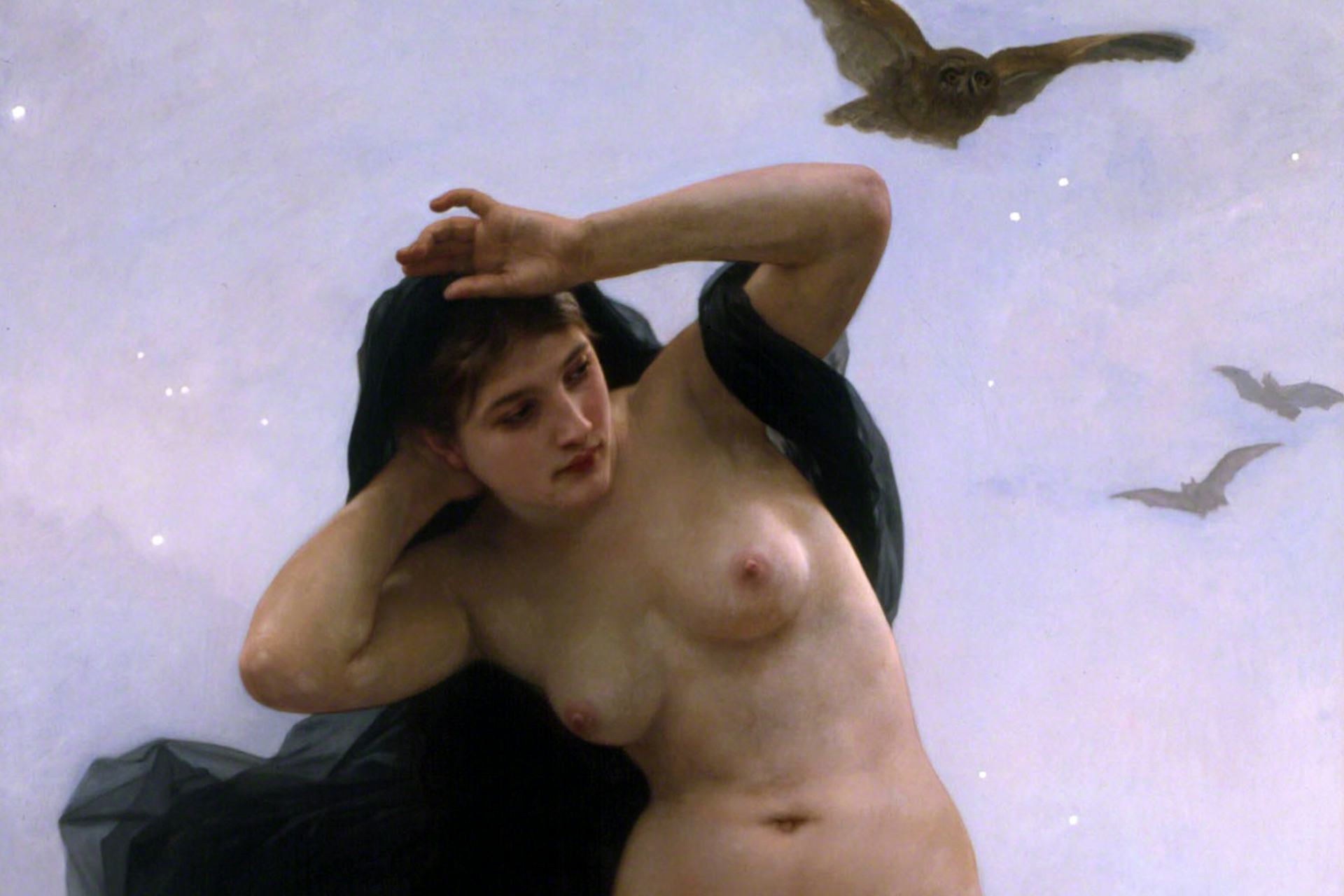Nyx

Night by William-Adolphe Bouguereau (1883).
Hillwood MuseumPublic DomainOverview
Nyx, the personification of night, was generally regarded as one of the mysterious primordial gods. Along with her brother-consort Erebus, she inhabited the dark recesses of the Underworld. An immensely powerful being, she was respected and feared even by Zeus.
In the common tradition, Nyx was a child of Chaos, the first entity of creation. She had numerous children, both with Erebus as well as on her own (that is, without the help of a consort). These children included Aether (“Upper Air”), Hemera (“Day”), and various other personifications and abstractions.
Etymology
The name “Nyx” (Greek Νύξ, translit. Nýx) is simply the Greek word meaning “night.” The word itself is derived from the Proto-Indo-European *nekwt-/nokwt- (“night”) or *negwh- (“become dark”). Almost all Indo-European languages employ a similar word for night (e.g., the Latin nox, the Gothic nahts, the Sanskrit nák, and the Lithuanian naktìs).[1]
Pronunciation
English
Greek
Nyx Νύξ (Nýx) Phonetic
IPA
[niks] /nɪks/
Alternative Names and Epithets
Nyx had a handful of epithets and alternative names. Some of these epithets emphasized Nyx’s nocturnal aspect: epithets such as κελαινή (kelainḗ), μέλαινα (mélaina), and ἐρεβεννή (erebennḗ), all of which mean “dark” or “black;” some epithets, such as ἱερά (hierá, “holy”) and ἀμβροσίη (ambrosíē, “ambrosial, divine”), highlighted Nyx’s importance as a goddess, while other epithets, such as ὀλοή (oloḗ, “ruinous”), highlighted the dread that the Greeks (like many others) associated with the night.
Nyx was sometimes also known by names such as Euphrone or Euphrosyne, from Greek words meaning “kindly” or “cheerful.”[2] Such euphemistic names were often applied to sinister powers as a way to placate them and neutralize their malignancy: compare the gentle title Eumenides, “Kindly Ones,” that was frequently used to invoke the grim Erinyes (“Furies”).
The Roman equivalent of Nyx was called Nox (from the Latin word for “night”).
Attributes
Functions and Characteristics
As the personification of night, Nyx was associated with darkness (similar to her husband Erebus, himself the personification of darkness). She was viewed as an extremely powerful goddess or cosmic force: Homer described her as she who “bends to her sway both gods and men,”[3] a goddess feared even by Zeus. The Romans associated Nyx with the hellish realm of death, magic, and witchcraft.[4]
Nyx rode through the heavens on a chariot drawn by black horses after Helios (the sun) had completed his daytime journey;[5] in some accounts, she was accompanied by Sleep personified, who held the reins,[6] and the dreams and stars moved in her baggage train.[7] Poets often imagined her clad in finery symbolizing her nocturnal dominion: a black robe studded with stars,[8] a wreath of poppy,[9] or with black wings growing from her shoulders.[10]
Nyx was usually said to live with her daughter Hemera (“Day”) in the darkness of the Underworld, somewhere in the far west in a region sometimes considered interchangeable with Nyx’s consort Erebus;[11] alternatively, her home was sometimes placed in the far north.[12]
Iconography
In ancient art (as well as literature), Nyx was represented as either winged[13] or riding a chariot,[14] stretching a cloak of night and stars across the sky. Sometimes she had a kind of dark, misty halo above her head or wore a veil. The Cypselus Chest, a celebrated ancient artifact known today only from ancient descriptions, represented a maternal Nyx cradling her children Hypnos (“Sleep”) and Thanatos (“Death”).[15] She appears relatively rarely in ancient art, and is often difficult to identify because of her resemblance to other celestial goddesses such as Eos and Selene.[16]
Family
Family Tree
Parents
Father
Siblings
Brother
Consorts
Husband
Children
Daughters
Sons
- Ker
- Hemera
- Oizys
- Hesperides
- Moirae (Fates)
- Keres
- Nemesis
- Apate
- Eris
- Philote
Mythology
Other Versions
Nyx was extremely important in the mythology of the Orphics, an ancient Greek religious community that subscribed to distinctive beliefs and practices (called “Orphism,” “Orphic religion,” or the “Orphic Mysteries”). Orphism was supposedly laid out by the mythical musician Orpheus and features important differences from traditional Greek religion.
Nyx appears to have been central to the Orphic theogonies (their mythological accounts of the origins of the gods and the cosmos)—much more so than in the more traditional theogony known from the poems of Hesiod. According to the Orphics, Nyx was usually the daughter of Phanes (or Eros), himself one of the first entities to come into existence as well as the original ruler of the cosmos (see above). But in some versions of the Orphic cosmogony, Nyx herself was the very first being of creation.[39]
Most Orphic traditions appear to have made Nyx one of the first rulers of the cosmos. She eventually passed the scepter to her son Uranus. From her oracular cave, Nyx continued to serve Uranus and his successors (Cronus and ultimately Zeus) as a respected adviser; in some accounts she even nursed the Titans and hid them from the vicious Uranus.[40]
Worship
In traditional Greek religion, the cult of Nyx was limited (the primordial goddess was probably more important in Orphism). But Nyx does appear to have been worshipped in connection with the oracles at Delphi[41] and in Megara at the temple of Dionysus Nyktelios (“Nocturnal Dionysus”).[42]
Nox, Nyx’s Roman counterpart, may have been honored by the Romans in connection with certain rituals for the dead (though our sources for these sacrifices may represent nothing more than poetic fancy).[43]